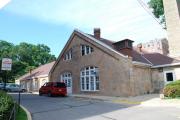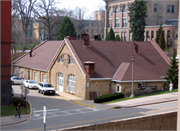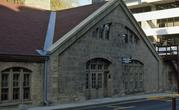Property Record
975 OBSERVATORY DR
Architecture and History Inventory
| Historic Name: | Metal and Mining Engineering |
|---|---|
| Other Name: | Radio Hall, Building #102 |
| Contributing: | Yes |
| Reference Number: | 101190 |
| Location (Address): | 975 OBSERVATORY DR |
|---|---|
| County: | Dane |
| City: | Madison |
| Township/Village: | |
| Unincorporated Community: | |
| Town: | |
| Range: | |
| Direction: | |
| Section: | |
| Quarter Section: | |
| Quarter/Quarter Section: |
| Year Built: | 1887 |
|---|---|
| Additions: | |
| Survey Date: | 1974 |
| Historic Use: | university or college building |
| Architectural Style: | Other Vernacular |
| Structural System: | |
| Wall Material: | Stone - Unspecified |
| Architect: | H. C. Koch |
| Other Buildings On Site: | |
| Demolished?: | No |
| Demolished Date: |
| National/State Register Listing Name: | Bascom Hill Historic District |
|---|---|
| National Register Listing Date: | 9/12/1974 |
| State Register Listing Date: | 1/1/1989 |
| National Register Multiple Property Name: |
| Additional Information: | A 'site file' (Bascom Hill Historic District) exists for this property. It contains additional information such as correspondence, newspaper clippings, or historical information. It is a public record and may be viewed in person at the Wisconsin Historical Society, Division of Historic Preservation-Public History. The Mining Engineering and Metallurgy Lab is now known as Radio Hall, because from 1934 to 1972 it housed the studios of WHA, the nation’s oldest continuously operating radio station. Designed by Milwaukee’s Henry Koch and built in 1887, the low-slung building has wide segmentally-arched openings, filled with multi-paned windows, reflecting the Romanesque Revival style. The murals in the lobby were painted under the auspices of the National Youth Administration, a New Deal agency that provided work for needy youth and college students during the Great Depression. Metal and Mining Engineering (Radio Hall) is contributing to the Bascom Hill Historic District, NR listed 1974, NRIS #: 74000065 "...built in 1887 as the original University Heating Station. In December of 1934 WHA Radio moved into the hall and began to refurbish the rather modest building. Along the lobby walls at the ceiling level are copies of petrographs (stone carvings) found on Indian cave walls along the Wisconsin and Mississippi Rivers. They were reproduced through federal grants from the National Youth Administration, established during the depression to provide work for college students. John Gallagher, a University student working with Wayne Claxton, Art, did the carvings and reproductions of Indian drums on the ceiling light fixtures and the oak furniture. The huge wall mural depicting the early days of radio on campus were painted by another student project worker, John Stella of Kenosha, in egg tempera. The purpose of the lobby's design was to harmonize the "oldest known means of communication" with the modern communication techniques, specifically WHA Radio, which originated the Wisconsin School of the Air and other pioneering educational programs. Prof. H. B. McCarty once wanted to renovate the building's outside, too, and called in architect Frank Lloyd Wright for advice. Wright took a long look at Radio Hall, and announced, "Don't touch it, my boy, it's one of the two honest buildings in Madison." WHA moved to Vilas Communication Hall in 1972. Radio Hall is now the home of UW-Extension's Instructional Communications Systems." University of Wisconsin-Madison, University of Wisconsin-Madison Tour Guide, 1988. |
|---|---|
| Bibliographic References: | Buildings of Wisconsin manuscript. University of Wisconsin-Madison, University of Wisconsin-Madison Tour Guide, 1988. |
| Wisconsin Architecture and History Inventory, State Historic Preservation Office, Wisconsin Historical Society, Madison, Wisconsin |





